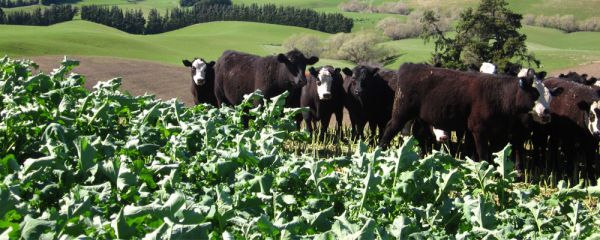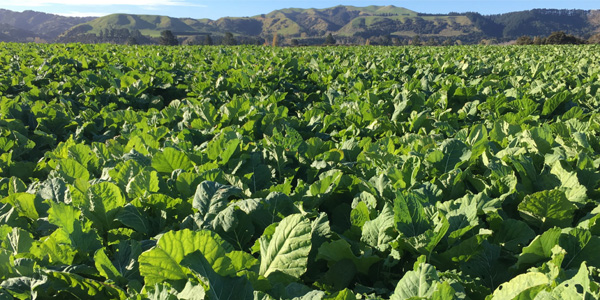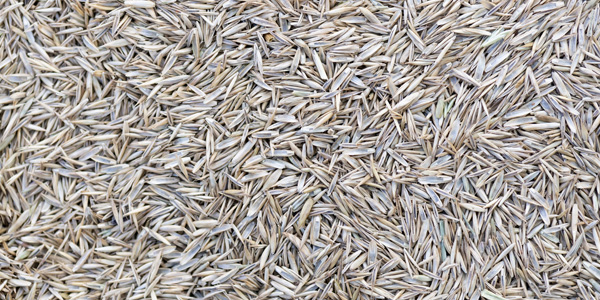
Animal Health
Animal Health
Animal Health & Welfare Considerations
SMCOS, Kale anaemia, Red water
SMCOS, Kale anaemia, Red water
As the name suggests this disorder is most commonly found when animals graze kale, however it can occur in all brassicas. It is most likely to occur in brassicas that have bolted or are flowering in spring. It may also become a problem if crops are grown in soils high in sulphur, or after sulphur fertilisers have been used.
Brassicas contain a non-protein amino acid called S-methyl cysteine sulphoxide (SMCO). During rumination SMCO is converted into a compound that can potentially damage the red blood cell membrane, allowing leakage of haemoglobin from the cell and ending up in the urine (hence the term red water). Moderate levels of SMCO may cause loss of appetite, ill thrift, mild anaemia and digestive upsets. High levels can cause severe anaemia and red coloured urine (red water). After an attack of poisoning, death can occur suddenly.
Follow best practice guidelines for feeding brassica crops, e.g. slow introduction and access to an alternative feed source etc. Be vigilant if you are grazing a crop that has started flowering and suspect there may be a problem. Soil testing prior to sowing will indicate the levels of key nutrients, including sulphur and assist in applying the right fertiliser for good crop growth. Ideally, limit the applications of sulphur and nitrogen. If kale anaemia is suspected, remove animals from the crop and keep under close watch until health is regained.
Key Tips
- Recognise situations where SMCO poisoning might be an issue
- Limit large inputs of sulphur and nitrogen
- When changing stock class in early spring to clean up remaining brassica crops, follow best practice for feeding crops
- Slow introduction (ensure transition feeding)
- Provide access to alternative feed source
Rape Scald
Rape Scald
Rape scald is a reaction by livestock to photodynamic plant chemicals in brassicas. Symptoms include reddening and swelling of the skin, commonly on the ears and face and possibly udders of sheep and cattle. Affected livestock generally attempt to seek shade, rub affected areas and may appear generally distressed. This condition is most commonly seen in lambs grazing immature or second-growth rape or other forage brassicas.
- The risk of rape scald can be minimised by delaying first grazing until crops have ripened (purplish/blue tinge on leaf margin is typical of a ripe crop)
- Avoiding excessive nitrogen and sulphur fertilisers and being vigilant to early signs
- Animals with scald should be removed from crop and offered shade
Some brassica species have minimal ripening requirements and are suited to situations when feed is required quickly and/or where ripening may be delayed by climatic conditions. However, under certain environmental conditions photosensitivity has been known to occur beyond the normal period of ripening.
Photosensitivity from Turnips
Photosensitivity is also possible with dairy cows grazing summer turnips and with other stock classes on summer turnips and leafy turnips. The cause of this condition is not well understood, for dairy cows the risk factors include: consuming large volumes of turnips (greater than one third of the diet) and feeding on crops under environmental stress.
- Crops should be accurately measured and allocation for dairy cows should be no more than one third of diet
- Animals with photosensitivity should be removed from crop and offered shade as soon as possible
In lambs grazing summer turnips (including Hunter) this condition is rare and unpredictable but may be associated with adverse and overcast weather conditions. This may be of particular concern to stud stock owners, where photosensitivity may cause cosmetic issues to sale animals.
Nitrates
When protein manufacture cannot keep up with nitrogen uptake in plants, the excess accumulates as nitrates, which when consumed are converted to nitrites in the rumen and can cause toxicity problems to grazing animals. When animals ingest high levels of nitrates, nitrites build up in the bloodstream. Here they bind with the oxygen carrying compound, haemoglobin, to form a compound that no longer is able to carry oxygen. Simply, the animal suffers oxygen deprivation.
The most common symptom of nitrate toxicity is sudden death, but prior to death, excessive salivation, rapid gasping breath, rapid pulse (>150 beats/min), pale blue or brown colouration of membranes, tremors and muscle weakness may occur. Pregnant animals surviving may abort.
Nitrates can build up in any situation where environmental conditions promote plant growth but limit photosynthetic activity. These include sudden temperature changes, dry periods followed by rain, frost, shading, overcast days, insect damage, some herbicides, some nutrient deficient soils, excessive nitrogen fertiliser use, soils with deficiencies in sulphur, phosphorus, molybdenum, or high acidity levels. Nitrate toxicity can occur on a range of grasses, brassicas, forage cereals and weeds. Young plants and plant material close to the ground are more likely to have high nitrate levels.
Treatment of Nitrate Toxicity
- Remove stock to low risk pasture
- Seek emergency veterinary assistance
Key Tips
- Recognise environmental conditions that cause nitrate build up and check animals more regularly during these periods
- Get suspect crops tested before grazing
- Introduce stock gradually to allow rumen adjustment
- Do not put hungry animals onto suspect crops
- Avoid overstocking of suspect crops as high grazing pressure will increase the amount of high-nitrate plant parts eaten
- When strip grazing, watch utilisation levels or graze for short periods
- Dilute high nitrate feed with a low nitrate feed source, e.g. hay, pasture, silage
- Make high nitrate forages into silage. Ensiling does not decrease nitrate levels but may be a way of managing high nitrate pastures by reducing the proportion in the diet
- Manage nitrogen applications carefully to match plant requirements and therefore avoid excess uptake and nitrate build up
- Do not allow animals access to nitrogen fertilisers, fertiliser storage areas, fertiliser spills or grazing on recently fertilised paddocks
- Take care when using nitrogen fertiliser around waterways, to avoid nitrate build up in drinking water
- Ensure that soil nutrient levels are in the optimum range for your farming system, as some nutrient deficiencies lead to nitrate build up
- Healthy animals are less likely to be affected than animals in poor health
- Remember that nitrate levels in animals are a combination of the nitrate consumed in their feed and their drinking water
Goitre
In some situations, iodine deficiency can occur when livestock are fed on brassica crops. This is because brassicas are naturally low in iodine and contain plant chemicals which are goitrogenic and inhibit iodine uptake. Iodine is important for growth and cell differentiation of tissues through its inclusion in thyroid hormones. Consequently, iodine deficiency has its greatest effect on the developing foetus and therefore may play an important role where pregnant livestock graze brassicas for extended periods in the final stages of pregnancy. The most marked sign of iodine deficiency is enlarged thyroid glands (goitre) but weak newborn lambs, low birth weights and a high rate of perinatal mortality may be subclinical signs along with poor wool growth and lower fertility in older stock.
Be aware of the iodine status of pregnant livestock grazing a brassica crop and consider an iodine supplement. Look for productivity clues that may signal an iodine deficiency.
Trace Elements
There is some evidence that animals grazing solely brassica crops do not receive sufficient trace elements and begin to deplete their liver stores. A trace element supplementation programme should be considered if animals are offered a sole diet of brassica for an extended period, or animals have a low trace element status prior to crop introduction. This may require soil, herbage and blood analysis and consultation with your veterinarian to establish current trace element status and the appropriate supplementation programme.
Mixing herbs and clovers with brassica crops is a strategy that may assist with increasing trace element availability to stock.

Our Brassica range
VIEW PRODUCTS




